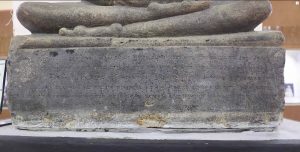| Metadata | |
|---|---|
| Inscription ID | PYU16 |
| Title | Socle of Kan Wet Khaung Mound Stone Buddha Image Inscription |
| Alternative titles | |
| Parent Object | OBPYU16 |
| Related Inscriptions | |
| Responsibility | |
| Author | Charles Duroiselle |
| Print edition recorded by | |
| Source encoded | |
| Digitally edited by | |
| Edition improved by | |
| Authority for | |
| Metadata recorded by | ERC team |
| Authority for metadata | |
| Metadata improved by | |
| Authoriy for improved | |
| Language | Pyu , संस्कृतम् |
| Reigning monarch | |
| Commissioner | |
| Topic | bilingual text with Pyu glossing Sanskrit; describes the reconciliation of kings Harivikrama and Candravarman and the consequent founding of two cities |
| Date: | |
| Min | 500 |
| Max | 600 |
| Comment | Although common methods of palaeographic dating are of little use when dealing with Pyu script, the fact that the present inscription includes portions not only in Pyu script but also, to write Sanskrit language, in a form of Northern Brāhmī script, opens the possibility of applying the palaeographic method to the latter script and to infer the date of the Pyu text by association. The Northern Brāhmī script of the Sanskrit text would under normal circumstances be dated to the period between 500 and 600 CE. This dating casts doubt on Blagden’s assumption “for the sake of convenience” (1913–14: 131) that the dates given in the Sriksetra urn inscriptions are to be interpreted in terms of the Burmese era beginning 638 CE, for the urns must be globally contemporary with the present inscription. However, allowing for an accuracy range of +/- 100 years in the palaeographic dating and for the potential for conservatism in the case of the employment of a script form (Northern Brāhmī) far away from its centre of active usage, the possibility that the present inscription was engraved in the 7th century, or even later, cannot be ruled out. Nonetheless, Griffiths et al. (2017: 101) are inclined to date the inscription to the 6th century. |
| Hand | |
| Letter size | |
| Description | Letter size not reported. The Sanskrit phrases are written in the "Late Northeastern Brāhmī" script that was used in inscriptions of the greater Bengal region in South Asia during the 6th and 7th centuries. The Pyu glosses are written in Pyu script. |
| Layout | |
| Campus: | |
| Width | |
| Height | |
| Description | The inscription is engraved continuously around the pedestal (socle) of a stone Buddha image (6 lines on the front side, 5 lines on each of the other sides). The sides of the socle are referred to here as follows: side A (the front), side C (the back) and sides b and d (the two short sides). Short spaces are inserted between Sanskrit phrases and their glosses in Pyu. |
| Decoration | |
| Bibliography | |
| References | Charles Duroiselle, in ASI 1927-28: 128, 145, first reported the discovery of this headless Buddha with a bilingual inscription in Sanskrit (“sometimes not quite correct”) and Pyu around its pedestal. The inscription is mentioned briefly in Ray 1936: 19-20, with more details in Luce 1937: 243-244. Tha Myat 1963: 41-43 labelled the script “Gupta Pyu” and provided eye drawings and Burmese transliteration for large face A and small faces b and d only. In Phases of pre-Pagán Burma (1985: I, 51, 57 n. 24, 65, 74 n. 22, 131-2), Luce cites earlier sources and reports that Dikshit and Blagden made unpublished readings. The inscription is discussed in Guy 1997: 91, Tun Aung Chain 2003: 5–6, and Guy 2014: 91-92. Sein Win 2016: 45-60 reproduces verbatim the parts published by Tha Myat and adds his own transliteration of the rest. Re-edited in the Corpus of Pyu Inscriptions (2017: PYU16). Edited and discussed with linguistic analysis in Griffiths, Miyake, Hudson and Wheatley, BEFEO 103 (2017): 88-149, 160-161, no. 16. |
| Add to bibliography | |
| Misc notes | |

